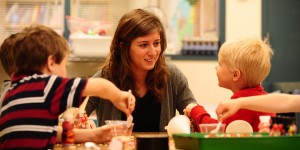
There is rarely a lack of energy in the Hesston College Lab Preschool, and the week in March learning about the importance of recycling was no exception. The preschoolers spent the week creating their own books, sorting recyclable items and creating 3-D art by gluing together recyclable materials.
The only difference was the lead teacher for the week was actually a student.
“I love working with the kids and applying what I learn in my classes to the preschool classroom,” said Deb Yoder ’11.
Yoder, of Apple Creek, Ohio, coordinated the entire week of preschool as part of her semester of field experience as an Early Childhood Education major. The week was structured to teach the reduce, reuse, recycle concept, and Yoder organized stories, songs, art projects and other activities for active learning.
“Being able to work directly with children through Hesston’s program has given me a lot of knowledge to back up how I interact with them, and made me more intentional in those interactions,” said Yoder.
For almost 40 years, the lab preschool has been an integral part of the Early Childhood Education curriculum. College students and pre-kindergarten children learn together and from each other.
As Yoder progressed through the program over two years, her responsibilities in the preschool increased. Students begin the program with observation – taking note of lead teacher Larisa (Miller) ’93 Lawrence’s interactions with the children, behaviors and how children respond to different teaching methods. They move on to planning one small or large group activity each week, help process weekly lesson plans and finally, as sophomores, function as an integral part of the planning and teaching team during their field experience.
The program reaches across a variety of college majors and gives students a chance to explore their interests in working with children. Some students use their two-year degree to join the professionals working in child-care programs or private preschools. Others transfer into teacher education or social science programs at four-year institutions.
“The preschool is a unique element of Hesston’s program,” said Tami (Birky) ’72 Keim, director of the Early Childhood Education program. “Students are able to develop their personal education philosophies as they work with the children. They also gain practical experience, which helps them learn more effectively. The preschool allows the students to make a direct connection between learning in class and preschool experiences.”
Someday Yoder hopes to own and operate her own preschool, but until then she plans to continue using her Hesston experience working in preschool or child-care settings.
“The guidance and constructive criticism I received from Tami and Larisa is invaluable,” she said. “I love seeing the obvious connections kids make in their learning. Seeing them figure something out for themselves is very rewarding.”

